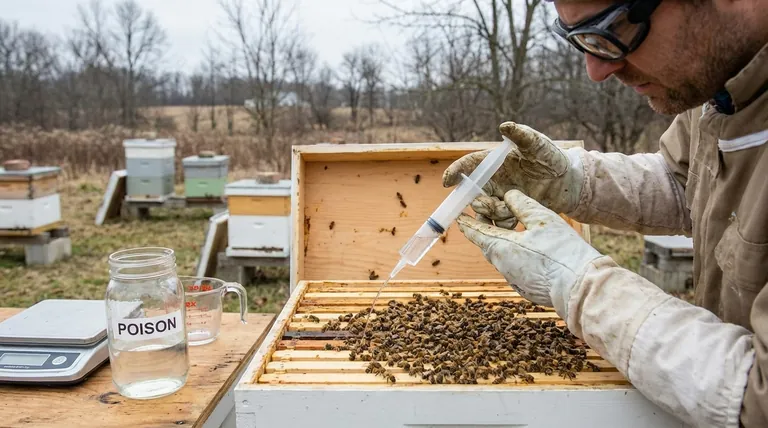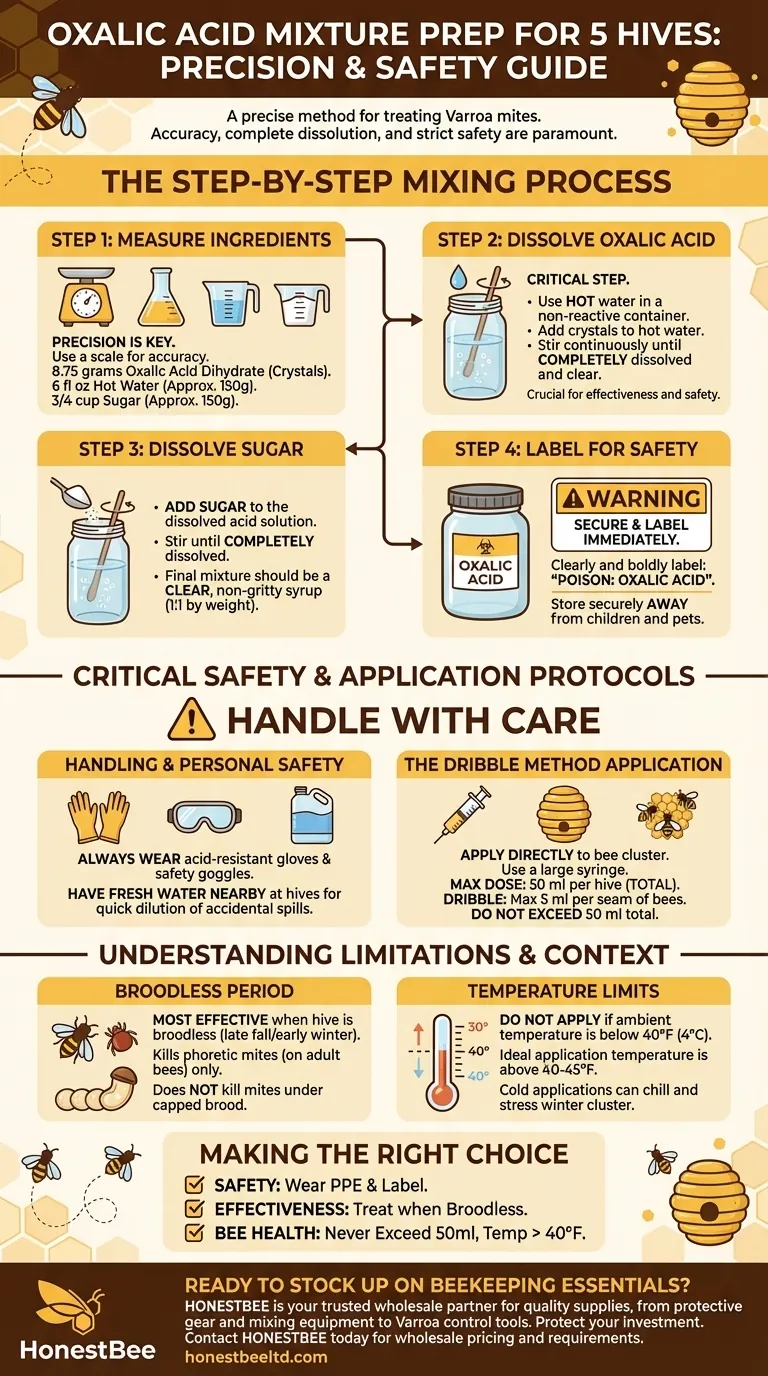To prepare the oxalic acid mixture for five hives, you will create a sugar syrup solution and dissolve a precise amount of oxalic acid dihydrate into it. This involves carefully measuring 8.75 grams of oxalic acid, dissolving it completely in 6 fl oz (150g) of hot water, and then dissolving 3/4 cup (150g) of sugar into the solution.
This procedure is not just about mixing ingredients; it's a precise method for creating a Varroa mite treatment. Success depends entirely on accurate measurements, complete dissolution of the crystals, and strict adherence to safety protocols to protect both you and your bees.

The Step-by-Step Mixing Process
The goal is to create a 1:1 sugar syrup by weight and then introduce the oxalic acid. Using hot water is critical for ensuring the oxalic acid crystals dissolve completely.
Step 1: Measure Your Ingredients
Precisely measure 8.75 grams of oxalic acid dihydrate crystals. Use a scale for accuracy.
Next, measure 6 fl oz (approximately 150 grams) of hot water and 3/4 cup (approximately 150 grams) of sugar.
Step 2: Dissolve the Oxalic Acid
Pour the hot water into a non-reactive mixing container, such as a glass jar.
Add the measured oxalic acid crystals to the hot water. Stir continuously until every crystal has fully dissolved and the solution is clear. This step is crucial for an effective and safe mixture.
Step 3: Dissolve the Sugar
Once the acid is dissolved, add the sugar to the solution.
Stir again until the sugar is completely dissolved. The final mixture should be a clear syrup, not cloudy or gritty.
Step 4: Label for Safety
Immediately and securely close the container.
Label it clearly and boldly as "POISON: OXALIC ACID" to prevent any accidental misuse. Store it safely away from children and pets.
Critical Safety and Application Protocols
Oxalic acid is a corrosive organic acid. Handling it requires care and the proper personal protective equipment (PPE). The goal is to treat the mites, not harm the bees or yourself.
Handling and Personal Safety
Always wear acid-resistant gloves and safety goggles when handling oxalic acid powder or the mixed solution.
Have a large container of fresh water nearby when you are at the hives. This is for quickly diluting any accidental spills on your skin, equipment, or the ground.
The Dribble Method Application
This mixture is designed for the "dribble method." You will apply it directly onto the bees clustered between the frames.
Use a large syringe to draw up to 50 ml (or 50 cc) of the solution. This is the maximum dose for one full-sized colony.
Gently dribble a maximum of 5 ml of the solution into each seam of bees between the frames. Do not exceed the 50 ml total per hive, even if you have more than 10 seams of bees.
Understanding the Limitations and Context
Effective Varroa mite treatment is about timing and understanding how the treatment works. Applying oxalic acid at the wrong time will yield poor results and may stress the colony unnecessarily.
The Importance of a Broodless Period
Oxalic acid treatments (both dribble and vaporization) are only effective against phoretic mites—the mites physically on the adult bees.
This treatment does not kill mites reproducing under capped brood. Therefore, it is most effective when the colony is broodless, which typically occurs in late fall or early winter.
Temperature is a Limiting Factor
You should not open a hive for this treatment if the ambient temperature is in the low 40s (°F) or colder.
Opening the hive in cold weather can dangerously chill the winter cluster, causing significant stress or death. The ideal temperature is typically above 40-45°F (4-7°C).
Making the Right Choice for Your Goal
Executing this treatment properly ensures you are helping your bees thrive by reducing their Varroa load at a critical time of year.
- If your primary focus is safety: Wear gloves and goggles without exception, and always label your mixture clearly as poison.
- If your primary focus is effectiveness: Apply the treatment only when your hive is broodless for the highest mite-kill efficacy.
- If your primary focus is bee health: Never exceed the maximum dose of 50 ml per colony and only treat when temperatures are safely above 40°F.
Properly preparing and applying this solution is a key step in responsible and successful beekeeping.
Summary Table:
| Ingredient / Step | Quantity / Action | Key Detail |
|---|---|---|
| Oxalic Acid Dihydrate | 8.75 grams | Use a precise scale for measurement. |
| Hot Water | 6 fl oz (150g) | Critical for complete dissolution. |
| Sugar | 3/4 cup (150g) | Creates a 1:1 sugar syrup by weight. |
| Final Mixture Dose | Max 50 ml per hive | Applied via the dribble method (5 ml per seam). |
| Optimal Application Time | Broodless period | Late fall/early winter for maximum effectiveness. |
Ready to Stock Up on Beekeeping Essentials?
As a commercial beekeeper or distributor, you need reliable, high-quality supplies to manage hive health effectively. HONESTBEE is your trusted wholesale partner for all your beekeeping equipment and treatment needs.
We supply everything from protective gear and mixing equipment to the tools required for precise Varroa mite control. Let us help you protect your investment and ensure the health of your colonies.
Contact HONESTBEE today for wholesale pricing and to discuss your specific supply requirements.
Visual Guide

Related Products
- 12V Bee Mite Removal Evaporator Oxalic Acid Vaporizer for Bee Fumigation Treatment 180W Atomization
- Adjustable Formic and Acetic Acid Dispenser for Bee Mite Treatment
- Professional Bamboo Queen Isolation Cage
- Varroa Easy Check Mite Tester Kit Counter Alcohol Wash Jar
- Professional Galvanized Hive Strap with Secure Locking Buckle for Beekeeping
People Also Ask
- What should be done after applying the vapor? A Step-by-Step Guide to Sealing Your Hive
- What is the role of oxalic acid in plants? A Key to Plant Defense and Internal Regulation
- What are the two popular methods for applying oxalic acid? Choose the Best Varroa Mite Treatment
- What are the supposed benefits of fogging oxalic acid over the dribble method? Speed, Coverage, and Bee Safety
- Can oxalic acid vaporization be used with honey supers on the hive? Ensure Legal Compliance & Honey Safety



















